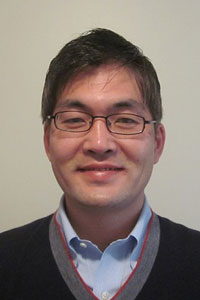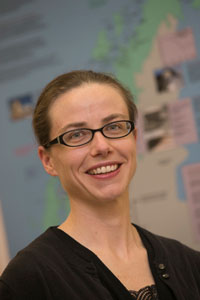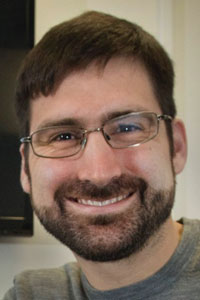SEED Grants 2015
Elucidation of Methanol and Ethanol Upgrading over 2-D and 3-D Zeolite Catalysts using In-Situ Methods at SBU, CFN and NSLS-II
| Tae Jin Kim Department of Materials Science and Engineering, SBU J. Anibal Boscoboinik Center for Functional Nanomaterials, BNL |
 Tae Jin Kim |
 J. Anibal Boscoboinik |
The global economy and energy are heavily dependent on crude oil for producing chemicals and materials. The escalating energy consumption and current fluctuating crude oil prices have led to increased interest in the use of shale gas, natural gas, or biomass as a feedstock for the production of transportation fuels (gasoline and diesel) and chemicals. Methanol and ethanol can be produced from such feedstock via syngas (CO and H2) and used as fuels and template chemicals. In spite of extensive studies using 3D zeolites, the understanding of methanol and ethanol upgrading, as well as catalyst deactivation, is far from being well-understood.
In this SBU-BNL joint project, we will concentrate on two important aspects of the methanol and ethanol upgrading process, namely: (1) Dimethyl ether (DME) and Diethyl ether (DEE) formation mechanisms by methanol and ethanol dehydration respectively and (2) Catalysts deactivation by coke formation which occurs concomitantly during upgrading reaction. The work proposed here will make use of a recently developed 2-D zeolite type model system, counting with the same bridging hydroxyl groups found within zeolite pores, but in this case exposed on a surface. This combined study between the 2-dimensional hexagonal (2dH) zeolite type model systems and 3D commercial zeolite catalysts, will provide new insights into the elementary steps aiding the future rational design of methanol and ethanol upgrading catalysts.
To this end, SBU PI (Prof. Tae Jin Kim, Materials Science and Engineering) and BNL PI (Dr. J. Anibal Boscoboinik, Center for Functional Nanomaterials) will team up and combine their expertise in catalysts synthesis, characterization, and activity test to carry out in-operando studies of these important chemical processes, taking advantage of instrumentation available at SBU and BNL, including the CFN and NSLS-II user facilities.
Novel Readout and Calibration Schemes for Cryogenic Noble Gas Particle Detectors
| Krishna Kumar Department of Physics & Astronomy, SBU Triveni Rao Instrument Division, BNL |
 Krishna Kumar |
 Triveni Rao |
We propose to research the feasibility of new techniques to measure, monitor and calibrate the response of a liquid Xenon Time Projection Chamber (TPC) as part of the nEXO experimental design. The nEXO detector is being designed to detect the rare process of neutrinoless double-beta decay in 136Xe with a half-life sensitivity in excess of 1027 years. We will develop a novel photoemission technique to monitor and calibrate the energy scale of the TPC response. We will test the conceptual design of a gold photocathode illuminated by 266 nm laser light to monitor the electron lifetime for drifting charge clusters in the TPC. We will also develop the first phase of the in-liquid “cold” two-dimensional charge readout electronics from a prototype tile. These concepts aim to overcome important technical hurdles to ensure that the nEXO TPC concept can satisfy the physics goals for a next generation double-beta decay experiment. Successful development of the techniques should find wide use in other cryogenic noble liquid detectors in nuclear and particle physics experiments.
Prototyping electric grid monitoring system based on sensors and GPS
| Serge Luryi Department of Electrical and Computer Engineering, SBU Michael Gouzman Department of Electrical and Computer Engineering, SBU Michael Villaran Sustainable Energy Technologies Department, BNL |
 Serge Luryi |
 Michael Gouzman |
 Michael Villaran |
We propose an electrical grid monitor system (EGMS) based on modern sensor and communication technologies. The proposed system will not require restructuring of the contemporary power distribution networks and can be applied both to the existing grids and the future “smart grids”. Our approach is based on a topological description of the connectivity aspects of the power grid.
Each power distribution network can be described by a Graph represented by Nodes of specified nature (such as generators, transformers, loads, switches, and storage units), their specified geographical position on a 2D map, and the topology of connecting lines. The state of the network can be adequately characterized by specifying the root-mean-square (RMS) currents and the direction of energy flow in all connecting lines. The instantaneous RMS currents are impractical to record, as they fluctuate on a short time scale; therefore averaging is required. The averaging is carried out synchronously over the entire grid over a specified time interval with global synchronization by the GPS. The grid connectivity is embodied in Kirchhoff’s current law at every node of the network; validity of this law is not violated by the synchronous averaging.
The awarded grant will enable us to demonstrate a small-scale version of the EGMS that can be tested in a micro-grid context. The BNL environment is an ideal venue for such testing. The proposed project explores the strengths of SBU in the development of GPS-synchronized sensors. Successful completion of the proposed project will enable new grant applications to both federal and state funding agencies. Moreover, it will enhance our negotiating position in pursuit of industrial and commercial opportunities.
Three-dimensional structure and function for ecological monitoring using unmanned-aerial systems and computer vision
| Heather J. Lynch Department of Ecology & Evolution, SBU Shawn P. Serbin Biological, Environmental, and Climate Sciences Department, BNL |
 Heather J. Lynch |
 Shawn P. Serbin |
Our project focuses on the development of an unmanned aerial system (UAS) sensor package that will increase our capacity to study the three-dimensional (3D) structure and function of environmentally-sensitive ecological systems. Two UAS-based 3D spectrometry systems will be developed, one at Stony Brook University and one at Brookhaven National Lab. Off-the-shelf multi-rotorcraft platforms will carry cost-effective optical cameras paired with high-spectral resolution spectrometers. Using a computer vision technique known as structure-from-motion (SfM), this system will allow us to create highly detailed 3D characterizations of landscapes together with simultaneously recorded information on surface and vegetation spectral reflectance with centimeter-scale spatial and vertical resolution.
Data from the spectrometer will enable the retrieval of plant biochemistry, physiology, and vegetation water stress over large geographic areas without compromising spatial resolution. When this information is integrated with 3D structure, it will allow for a much more sophisticated understanding of energy, nutrient, and water fluxes, as well as the 3D canopy radiation regime. In addition, these platforms will enable the 3D spectral mapping of vegetation and other ground targets in the Antarctic and sub-Antarctic islands, where the fragile ecosystem makes surveys difficult. For example, when combined with the spectral signature of guano, this system will enable the remote examination of penguin diet, potentially allowing us to detect shifts in the Southern Ocean food chain.
Once this technology is developed and tested, it will provide a cost-effective rapid survey module that will deliver 3D information on how physical structure (of a landscape, an individual tree or an entire forest) determines, and is determined by, ecological function. The development of these UAS platforms and integrated sensor packages will provide immediate benefits for the research groups involved in this project and create new funding opportunities for both institutions.
Enabling Stable Nanocrystalline Tungsten Alloys as Plasma-facing Materials for Fusion Reactors
| Jason R. Trelewicz Department of Materials Science and Engineering, SBU Simerjeet K. Gill Nuclear Science and Technology Department, BNL |
 Jason R. Trelewicz |
 Simerjeet K. Gill |
Plasma-facing components (PFCs) for reactor scale fusion devices require materials to operate under far-from-equilibrium conditions of extreme temperature, radiation, and stress. While tungsten has emerged as a promising candidate due to its high melting temperature, exceptional strength at elevated temperatures, and good sputtering resistance, the realization of tungsten as a next-generation PFC material requires revolutionary advances in alloy design to limit irradiation-induced damage at high temperatures. One approach for enhancing radiation tolerance involves the refining of grain size to the nanometer regime. The resulting nanocrystalline structure is composed of a high density of grain boundaries, which limit the accumulation of irradiation damage by defect absorption at these boundaries; however, nanocrystalline grains are notoriously unstable at elevated temperatures, and their growth would eliminate the high density of available defect sink sites and corresponding damage tolerance. The objectives of this research are to elucidate the mechanisms of nanostructure stability in tungsten alloys with evolving grain boundary structures, assess their implications for defect absorption, and engineer the solute distribution and grain size at the nanoscale to produce stable alloy states. Activities combine atomistic simulations with in situ irradiation exposure and nanomechanical testing of novel tungsten alloys to understand the mechanisms responsible for their stability, radiation tolerance, and deformation physics at the nanoscale. Fundamental insights into the principles of nanostructure stability and their implications for radiation-tolerant alloy design will be uncovered with specific focus on elucidating the role of dynamic defect states for enhancing thermal stability and radiation tolerance. From this research, a new understanding of radiation effects in tungsten alloy nanostructures will be developed to markedly enhance their potential as advanced PFC materials and provide opportunities for their exploration in future reactor platforms.
